Leather can be made from almost any skin and that includes making fish skin leather. It might be difficult to imagine fish skin as leather because the skin is very thin, but it is very strong and has good water resistant qualities.
Fish skin leather is made from skins of non-endangered fish species including salmon, shark, carp, bass, sturgeon and catfish. The art of making leather out of fish skin, is an ancestral craft, which has almost been lost due to industrial techniques that have taken over in leather production.
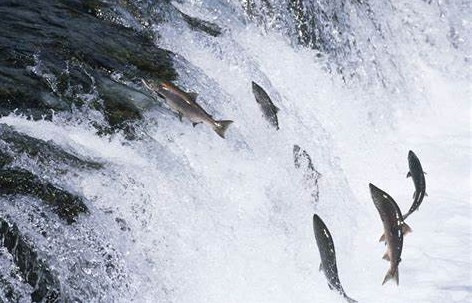
Fish canneries normally dump the skins in the ocean, but over the past twenty years, this ancient craft is being revived and fish skin leather has been under development and is being brought back to life. By using a by-product of the fish industry, a waste item is turned into footwear, garments and other useful household articles.
Production of Fish Skin Leather
Fish skin can be turned into leather just like any other animal hide and the process takes about a month for the skin to be ready to be used.
- The first step is to clean the inside of the skin by scraping it to remove any flesh. In a commercial setup a fleshing machine is used to remove any excess flesh. To remove the scales on the outside of the skin, the skin is scraped in the opposite direction to which the scales grow. Cleaned fish skin looks a bit like the skin from reptiles.
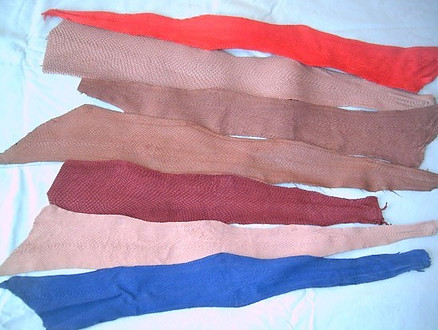
- The skins are placed in a drum with chemicals for the tanning process. The skins stay in the drum where it spins around for a week. Fish are cold-blooded creatures, so the skin does not like high temperatures.
- Care needs to be taken with the temperature and the skins must not be allowed to boil. This removes the oil and any remaining flesh and odour from the fish skins. The special tanning process prevents the fish skins from becoming hard and stiff once all the oil has been removed.
- Once the fish skins are removed from the drums, it is washed and dyed and then stretched over a board overnight. This helps to dry the skins and it is then softened to produce fish skin leather.
Tanning is done to make the skin supple and prevent it from rotting. It is a chemical and mechanical process with the skins being fleshed, soaked, churned and vacuum dried. The first item that is needed in tanning is a tannic acid. Industrial tanneries currently use mineral salts, such as chromium salts, as tannins. It is a chemical compound that easily mix with other substances, and therefore production time is reduced.
Fish skin leather is not vegan, so if you would like to explore vegan leather alternatives, then please read this related post: 5 Innovative Textile Solutions for Vegans.
The fish skin that is mostly used in leather production is salmon, so we will have a closer look at the production of salmon skin leather.
Salmon Skin Leather 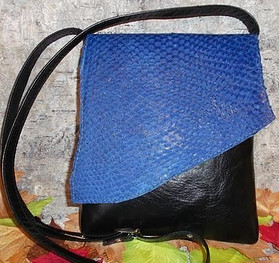
Salmon skin leather is a sustainable new and innovative material from salmon, that is organically farmed for human consumption. Skins are also derived from salmon that lives in the Pacific and Atlantic oceans.
The eco friendly leather is made by re purposing a by-product of the commercial salmon industry, namely salmon skin. Salmon skin is normally discarded, but through re purposing salmon skin, a new leather alternative is available.
Salmon skin leather has some unique properties, not only physically, but aesthetically as well. It is a very strong, thin and flexible material and more eco friendly than normal leather derived from cattle skin. It has been compared to snake skin leather, but it has a softer, suede like feel to it.
Processing Methods
Two different processing methods are used to make salmon leather and they will produce different color effects. The color base plays a crucial part in the dyeing process.
- Normal processing method will result in a solid color without any contrasts. The natural grey color of salmon skin is removed, allowing the leather to be dyed any color, even white. The resulting color is solid, without the natural two-tone effect of the belly and the back. The scale pattern is also less noticeable. Most salmon leather is processed in this way, hence it being called “normal”.
- NAC method would retain the natural two-tone look of salmon skin, with contrast between the pale belly and the dark
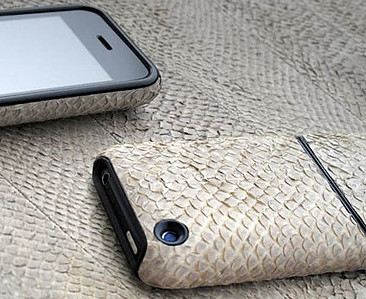 back. The scaly texture is more noticeable and the grey base color remains. The range of colors that are available with the NAC method is more limited and white for instance is not possible. Salmon is naturally darker during the winter than the summer, so when working with undyed NAC, this seasonal difference would show. It will not have an effect on dyed salmon leather.
back. The scaly texture is more noticeable and the grey base color remains. The range of colors that are available with the NAC method is more limited and white for instance is not possible. Salmon is naturally darker during the winter than the summer, so when working with undyed NAC, this seasonal difference would show. It will not have an effect on dyed salmon leather.
Both washable salmon leather and vegetable tanned leather are produced. The soft feel and texture make it an ideal material for protective covers of personal electronic devices, such as laptops and mobile phones.
Bigger pieces and rolls of salmon leather is also being produced. Several patented adhesion and seaming processes are used to make big pieces or rolls of leather. It is also available in the actual fish size for smaller articles.
Properties of Salmon Skin Leather
- One hundred percent of the salmon skin can be used, so there is no loss.
- Salmon skin leather is more eco friendly than traditional leather.
- It has a completely unique three-dimensional natural texture.
- It is a completely innovative and new material.
- Salmon skin leather is both stronger and more flexible than natural leather. The strength is due to cross fibers in the skin.

- Fish skin leather is stain and scratch resistant.
- It is water repellent and doesn’t need polishing.
- Original patterns are available to order.
- Several color combinations are available.
- It is available in large linear panels or actual fish size for smaller articles.
Vegetable tanned salmon leather is used to make sustainable house slippers. The unique slippers are hand made by women artisans in Patagonia, Chile. Uppers are hand knitted, using locally sourced sheep’s wool.
The salmon leather is upcycled from the local fishing industry, using a waste product that would have been thrown away. The durable, sustainable leather is soft and unique.
Each pair includes a QR code with information of the artisan and geo-location. It also includes a repair kit to personalize your slippers, or repair if needed.
Is Fish Skin Leather Eco Friendly?
The fish leather industry is still small scale and many make use of a circular economy. It means that many of them are quite secretive about the processes and materials that they use. Production facilities are found as far afield as Lapland, Iceland, Canada, Mexico, the Philippines, Europe and Africa.
These are some of the eco friendly and sustainable methods that are used.
- A production plant in Iceland makes use of geothermal energy, making it more sustainable and eco friendly.
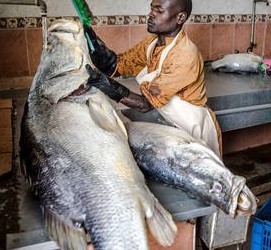
- There is a small leather workshop in Archachon Bay, Bordeaux, France where they are using eco-responsible methods in a circular economy. Fish skins are obtained from the local fishermen and fishmongers, thereby turning a waste product into fish leather. Local plants, such as crushed mimosa root bark, are used as tannins. It is a more natural alternative to chemicals and it is a zero waste process.
- A Dutch company is making sustainable salmon leather.
- A Romanian start-up company is using organic and synthetic tanning methods, without any toxic chrome compounds, to produce eco friendly and sustainable salmon skin leather.
- Any skins that are damaged are used for producing pet food, further reducing any waste.
- Vegetable tanning refers to leather tanned with plant materials and these would normally be oak, chestnut and spruce bark.
- Banana extract, which is sustainable and natural, is used to get rid of any odours at a production facility in Kenya.
- Scales can be used for art projects and in jewellery making further reducing any possible waste.
Final Thoughts On Fish Skin Leather
The price of fish skin leather is still high and more expensive than calf leather, but it is creating new opportunities for artisans and designers. Fish skin leather is used to produce belts, shoes, sword handles, jewelry, bags and other accessories. Design houses like Dior, Gucci and Prada are using fish skin leather to produce exclusive footwear and fashion articles.
Traditional leather is discussed in this post: What is Leather? The Rawhide From Animals.
If you have any questions or experience with salmon skin leather, please leave your comments below and I will get back to you.

This is very interesting content, I never knew fish skin could turn out to be a tough fabric. I have a couple questions, can you make clothes out of fish skin leather? I would assume not because it would take literally forever to make. Also could you possible be able to still eat the fish skin after it’s transformed to leather?
Hi Joshua, I can only assume you mean this as a joke – no you cannot eat the fish skin after it has been transformed into leather. Do you eat your shoes for dinner? Assuming they are leather from cow hide and not some plastic product. If you had read the post it would give you all the details of how fish skin leather is made and what it is used for
Hi! This was a very interesting article. I didn’t know that we could obtain leather out of skin fish. And I love the idea of it being eco-friendly.
I’m excited about this and I would like to buy a phone case or a bag made of fish skin leather. I also found interesting to read about these companies in Canada, Iceland, Mexico and Europe that are working with fish skin leather. Thanks for his post!
Fish skin leather is indeed something that I didn’t know existed until I researched normal leather and came across salmon skin leather.
Hi Henry
i have a project around fish leather and your expertise would be really helpful
is there a way to reach you more privately?
Hi, You can send an email. Thank you
Hi Liné Cowley
I’ve only started researching this topic this week! Going by your views, Fish Skin Leather production has been practiced primarily by peoples living/surviving in the very cold climates of Northern hemisphere countries.
I am planning a Fisher project in the Tropics where average temperatures range from 29-33 deg C. In the dry hot season it could go much higher into 40+ C. There is substantial waste between catching and marketing through spoilage, currently 30% of the catch. The idea, that we might eliminate this waste by processing the Fish ourselves and then have two by-products by using Fish Skin and Scales, creates symbiosis which might reduce Cost-of-Production. The project is primarily Poverty Alleviation oriented – to provide a livelihood for marginalised women.
I’d be grateful for any details you could provide on all aspects & stages of this product & processes.
Kind regards
Rod
PS: Long years ago I used to work in large scale commercial dairying & ranching in Central Africa.
Hi Rod, thank you for reaching out. Unfortunately I don’t have more details on what a Fisher project is, or the processes that might reduce your cost of production. All the best in providing a livelihood for marginalised women and alleviating poverty. Liné
Hi, Liné Cowley
Before I saw this article you wrote about Fish skin leather, I always thought that the Fish skin leather sold on the market was made by hand, but now I have changed my opinion.
You said that it takes a month for Fish skin to become leather. I think it costs a lot. Is it better to use leather to make leather?
A lot of the fish skin leather is indeed made by hand in small artisan leather workshops. There is a commercial operation in Canada and Iceland and indeed fish skin leather costs more than calf leather.
Honestly I haven’t heard much about fish skin leather so I was pleasantly surprised to come across your post here. It makes sense as fish skin naturally has excellent water resistance. I think the history of fish skin leather is pretty fascinating and it’s nice to see that it’s coming back. If we can be more resourceful as a society we are better off. Rather than throw the fish skin away it’s a brilliant idea to reuse it to make leather. It will be interesting to see if any high-end designers get into the shark skin hand bags. Great post you really have me thinking here and I will check out your links, excellent!
Thank you, some fashion houses like Dior and Gucci are using fish skin leather and far better to convert a waste product into a useful article
Wao this is really amazing. I find this post really fascinating. Maybe the personal bias is due to the fact that I love fish. Its SK comforting to know that I can actually have amazing products made from fish skin.
I can’t wait to get all my desired products. Could you please send me the link to where I can get the Fish leather skin phone cover?
Great that you can enjoy your favourite fish and know that the skin can be converted into a useful article and not go to waste. I will send you the link
Wow! I never would have thought of using fish for leather. Now I’m really interested! I’m sorry, I missed the part where you say whether or not you scrape the scales off? Do you scrape them off and then the skin still has that natural scaly look to it? This is truly amazing. I’ve just recently started looking into leather tanning and using it for projects, so this is something I am definitely wanting to learn more about! Thank you!
Hi there, yes, the scales are scraped off in the opposite direction to which they grow. The scales can then be used for making jewellery or other projects, so no waste. If you are interested in how normal leather is made, I have done an article on it and this where you can read more.
Very interesting to know so much about a very small industry as the fish skin leather industry but I must say that I Really learned WL through all these that I have read right now. It is definitely right for them to make productions very eco friendly and besides the process of making it seems long and cumbersome. Going by all you have written here, I think it is still very much eco friendly unless they decide to change their operations anytime soon
Hi Shelley, it is still a small industry but most of it is eco friendly and sustainable
I must admit I never thought its possible to make leather from the skin of fish and seeing its possible is really fascinating, it feels like I should get mine right away. So far there have been so many fish skin inahve come across and would love to see on a product like a bag or something. These companies with top names should make some things from this fish skin and I believe so many people will opt to get it. I look forward to getting a product of such design for myself. Best regards.
Hi Chloe, it is indeed possible to get fish skin leather products